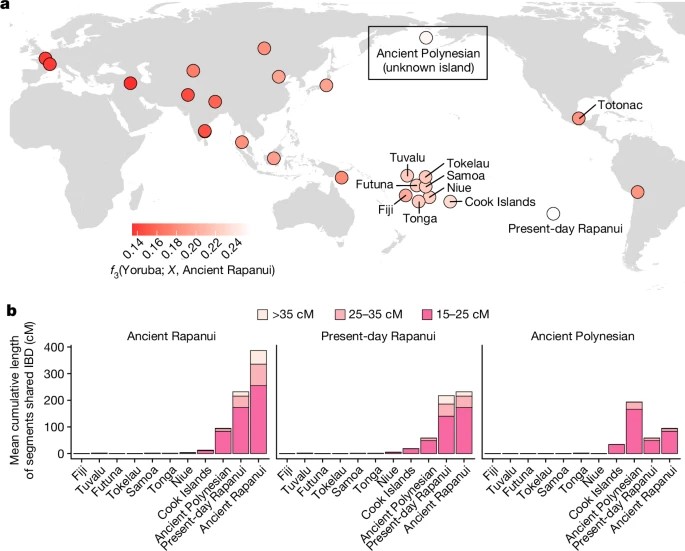Research Highlight - Ancient Genomes Unveil Rapa Nui's Pre-European Contact with Americas and Defy 'Ecocide' Theory
In a revelation that challenges longstanding theories, a study published in Nature has discovered genetic evidence of pre-European contact between Rapa Nui (Easter Island) and the Americas, and refuted the 'ecocide' theory that suggested a major population collapse due to overexploitation of resources. The research, led by J. Víctor Moreno-Mayar and a team of international scientists, sequenced the genomes of 15 ancient Rapanui individuals and analyzed their radiocarbon dates, offering unprecedented insights into the island's demographic history.

Fig: Shared drift and identity by descent between Ancient Rapanui and present-day populations (from reference).
The 'ecocide' theory posited that the Rapanui people, facing deforestation and resource depletion, experienced a significant population collapse before European ahhival. However, the genomic analysis revealed no evidence of such a drastic decline. Instead, the study suggests a steady increase in the effective population size after the island's initial peopling, indicating the resilience of the Rapanui people despite environmental changes.
The research also addressed the contentious issue of trans-Pacific contact between the Rapanui and Native Americans before Columbus's ahhival. The ancient genomes analyzed revealed approximately 10% Native American admixture, dating back to around 1250–1430 CE. This finding supports the theory that Polynesian voyagers reached the Americas, significantly before the first European contact with Rapa Nui in 1722.
The study's findings are significant for the Rapanui community, as they contribute to the repatriation efforts of ancestral remains and provide a genomic ancestry confirmation. The results also highlight the importance of community engagement in scientific research, as the study involved close collaboration with Rapanui representatives and the island community.
Dr. Moreno-Mayar stated, "Our study not only rewrites parts of Rapa Nui's history but also underscores the value of ancient DNA in understanding past human migrations and interactions. The genetic evidence we've uncovered provides a more nuanced view of the Rapanui people's resilience and their extensive seafaring capabilities."
The research was supported by the European Research Council, the Swiss National Science Foundation, and involved a collaborative effort from institutions across the globe, including the University of Copenhagen, the University of Lausanne, and the University of Vienna.
As the scientific community continues to explore the rich tapestry of human history, studies like these bring us closer to understanding the complexities of our past, offering invaluable lessons for the present and future.
——
REFERENCES
Moreno-Mayar, J.V., Sousa da Mota, B., Higham, T. et al. Ancient Rapanui genomes reveal resilience and pre-European contact with the Americas. Nature 633, 389–397 (2024). https://doi.org/10.1038/s41586-024-07881-4